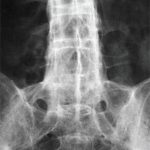 Axial spondyloarthritis (SpA), an inflammatory disease of the spine and sacroiliac joints, causes new bone formation that may lead to total ankylosis of the spine. Laura C. Coates, MBChB, PhD, associate professor of rheumatology at the University of Oxford, U.K., and colleagues sought to describe the relationship between the presence of HLA-B27 and the radiographic phenotype of axial SpA. They found patients with axial SpA who were positive for HLA-B27 had more severe radiographic damage than patients who were negative for HLA-B27. These HLA-B27-positive individuals also had more marginal syndesmophytes and more frequent syndesmophyte symmetry than those who were negative for HLA-B27. The investigators published their findings in the June 2021 issue of Arthritis Care & Research.1
Axial spondyloarthritis (SpA), an inflammatory disease of the spine and sacroiliac joints, causes new bone formation that may lead to total ankylosis of the spine. Laura C. Coates, MBChB, PhD, associate professor of rheumatology at the University of Oxford, U.K., and colleagues sought to describe the relationship between the presence of HLA-B27 and the radiographic phenotype of axial SpA. They found patients with axial SpA who were positive for HLA-B27 had more severe radiographic damage than patients who were negative for HLA-B27. These HLA-B27-positive individuals also had more marginal syndesmophytes and more frequent syndesmophyte symmetry than those who were negative for HLA-B27. The investigators published their findings in the June 2021 issue of Arthritis Care & Research.1
Study Design
The large international, observational, cross-sectional study included a mixed population of individuals with axial psoriatic arthritis (PsA; n=244) and ankylosing spondylitis (AS; n=198) from eight sites in Europe and North America. The investigators gathered basic demographic data, a recent patient-completed disease activity measure (the Bath Ankylosing Spondylitis Disease Activity Index [BASDAI]) and a recent measure of C-reactive protein (CRP).
One-quarter of the patients with PsA tested positive for HLA-B27, and three-quarters of the patients with AS were positive for HLA-B27. Patients who were HLA-B27 positive had a mean age of 49.1 ± 14.2 years, whereas patients who were HLA-B27 negative had a mean age of 53.8 ± 13.8 years. HLA-B27 positive patients were also more likely to be male (73%) than HLA-B27 negative patients (59%). HLA-B27 positive patients had disease duration of 13.6 ± 11.9 years, whereas HLA-B27 negative patients had a disease duration of 11.0 ± 10.2 years. Lastly, patients who were HLA-B27 positive had a mean BASDAI score of 4.1 ± 2.0 compared with a mean BASDAI score of 3.5 ± 2.4 for HLA-B27 negative patients. All of these differences were statistically significant.
Study Results
Blinded to the clinical details, the investigators read the radiographs by consensus in a single, central location. They recorded the symmetry of the sacroiliac joints and lumbar syndesmophytes and the morphology of the syndesmophytes, together with the modified Stoke Ankylosing Spondylitis Spine Score (mSASSS) and the Psoriatic Arthritis Spondylitis Radiographic Index (PASRI). The mSASSS evaluates the corners of the vertebral bodies from the lower border of C2 to the upper border of T1 and from the lower border of T12 to the upper border of S1. The PASRI evaluates the vertebral bodies and the zygo-apophyseal joints at C2/C3, C3/C4 and C4/C5 for fusion. The PASRI also scores the sacroiliac joints.
In the study, 60 of the patients with SpA were positive for HLA-B27 and 148 of the patients with AS were positive for HLA-B27. The investigators performed multivariable logistic regression using age, sex, HLA-B27 status, duration of disease and diabetes mellitus status as independent variables. They found patients who were HLA-B27 positive had more severe radiographic damage as measured by mSASSS and PASRI than those who were HLA-B27 negative. Likewise, patients who were negative for HLA-B27 were more likely to have bilateral normal sacroiliac joints (grade 0 or 1), and less likely to have bilateral grade 4 sacroiliac joints than those who were HLA-B27 positive. Although not all patients in the study had syndesmophytes on the anteroposterior view of the lumbar spine, syndesmophytes were more frequently seen in HLA-B27 positive individuals than in HLA-B27 negative individuals, and the only predictor of syndesmophyte symmetry was HLA-B27 positivity. However, HLA-B27 positivity was not associated with sacroiliac symmetry.
The current study suggests there is less difference in radiographic phenotype between AS and axial PsA than has been previously documented. It emphasizes the importance of HLA-B27 status in the radiographic severity and phenotypic expression of disease. The authors conclude that their study has implications for the diagnosis and classification of spondylitis in people with psoriasis. In particular, the authors feel that existing classification criteria may not be applicable to axial PsA.
Axial Involvement in PsA
Lead investigator Philip S. Helliwell, MD, professor of Clinical Rheumatology at the Leeds Institute of Rheumatic and Musculoskeletal Medicine, U.K., explains that although there is axial involvement in PsA, the presentation can differ from axial involvement in AS. He feels that most rheumatologists are familiar with the classical presentation of axial involvement seen in patients with AS and may be unaware of the non-classical presentation that can occur in patients with PsA. His study tested the hypothesis that the radiographic phenotype of patients with axial SpA depends on the presence of HLA-B27 as opposed to the diagnosis of PsA or AS and his results suggest the genotype drives the phenotype.2
Dr. Helliwell points out that this evidence builds on a body of data going back to 1971 when McEwen et al. published a comparative study indicating that spondylitis associated with psoriasis has a close resemblance to spondylitis associated with reactive arthritis and has features that distinguish it from AS. In their seminal study, the researchers noted the asymmetry and distinctive syndesmophytes in psoriasis and proposed several hypotheses to explain the differences between classical axial SpA and non-classical axial SpA (psoriatic and reactive).3
In 1998, Dr. Helliwell and colleagues published an analysis of radiographs that further advanced the understanding of the differences between the radiological features of classical axial SpA and nonclassical axial SpA.4 However, he says not all rheumatologists acknowledge the different presentations of axial SpA, believing instead that patients either have axial involvement or they do not—the differences being merely quantitative.
Although Dr. Helliwell is convinced the presence of HLA-B27 drives phenotypic expression of disease, he points out that the Assessment of Spondyloarthritis International Society (ASAS) classification for axial SpA has a clinical arm requiring the presence of HLA- B27 and that patients with axial PsA are less likely to meet this criterion.5 Thus, the criteria may not be optimal for axial PsA.5
“This matters,” says Dr. Helliwell, “because in some countries, if you can’t get a diagnosis, you can’t get access to treatment.”
Dr. Helliwell believes the latest study continues to build the case that there are two phenotypes of axial disease—the classical and the non-classical—and that individuals with axial PsA are more likely to have the non-classical phenotype. He also hopes the study paves the way for patients with PsA to access drugs that are effective for axial involvement. He points to the currently enrolling study of the interleukin 23 inhibitor guselkumab administered subcutaneously in biologic-naive participants with active axial PsA (NCT04929210) and believes this study, as well as the ASAS and the Group for Research and Assessment of Psoriasis and Psoriatic Arthritis (GRAPPA) collaboration to define new classification criteria for axial PsA (NCT04434885), will help in the development of better classification criteria for axial SpA.
Lara C. Pullen, PhD, is a medical writer based in the Chicago area.
References
- Coates LC, Baraliakos X, Blanco FJ, et al. The phenotype of axial spondyloarthritis: Is it dependent on HLA-B27 status? Arthritis Care Res (Hoboken). 2021 Jun;73(6):856–860.
- Feld J, Chandran V, Haroon N, et al. Axial disease in psoriatic arthritis and ankylosing spondylitis: a critical comparison. Nat Rev Rheumatol. 2018 Jun;14(6):363–371
- McEwen C, DiTata D, Lingg C, et al. Ankylosing spondylitis and spondylitis accompanying ulcerative colitis, regional enteritis, psoriasis and Reiter’s Disease: A comparative study. Arthritis Rheum. 1971 May–Jun;14(3):291–318.
- Helliwell PS, Hickling P, Wright V. Do the radiological changes of classic ankylosing spondylitis differ from the changes found in the spondylitis associated with inflammatory bowel disease, psoriasis, and reactive arthritis? Ann Rheum Dis. 1998 Mar;57(3):135–140.
- Rudwaleit M, Landewe R, van der Heijde D, et al. The development of Assessment of Spondyloarthritis International Society classification criteria for axial spondyloarthritis (part I): Classification of paper patients by expert opinion including uncertainty appraisal. Ann Rheum Dis. 2009 Jun;68(6):770–776.


